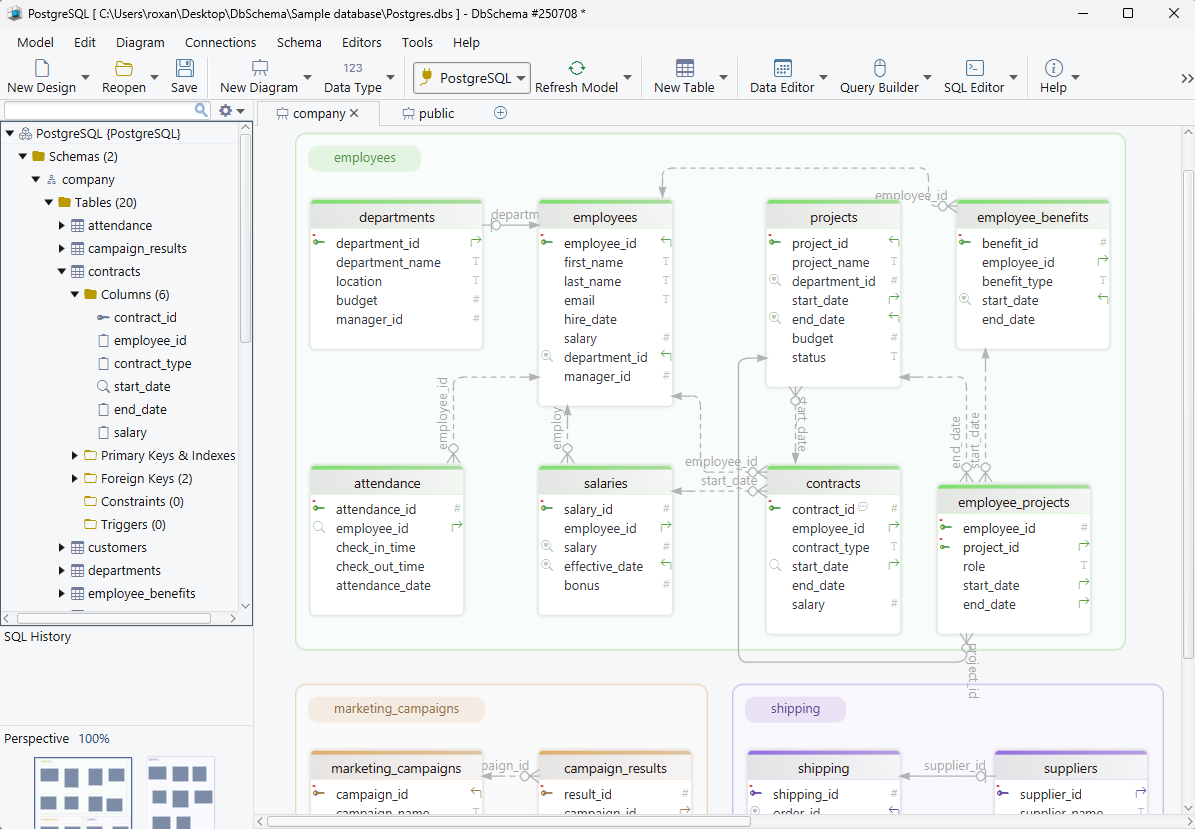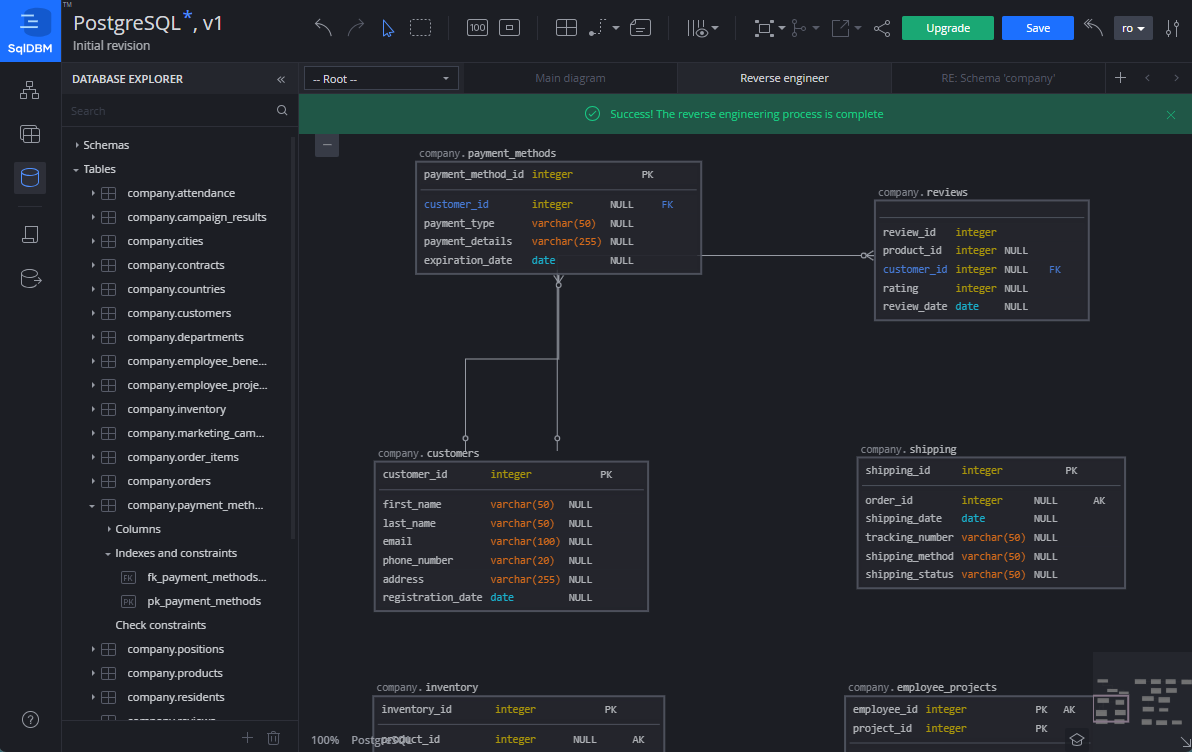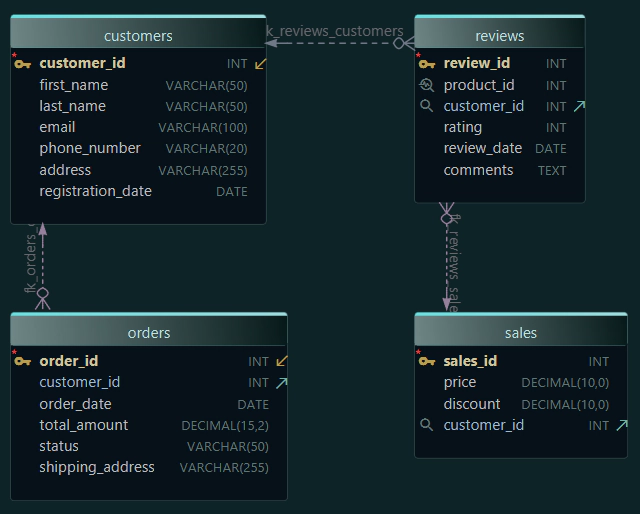Top Free ER Diagram Tools for PostgreSQL in 2025

When working with PostgreSQL, especially on bigger projects or with other people, understanding the structure and relationships in your database is key.
What Makes a Good ER Diagram Tool?
Choosing the right ER diagram tool depends on what you need for your project. Still, there are a few features that are useful no matter your level of experience:
- Simple interface: The tool should be easy to use, even if you're not a database expert.
- Diagram features: Look for tools that let you build and customize diagrams easily, so you can clearly show how tables relate to each other.
- Database support: Make sure the tool works with PostgreSQL or any other databases you plan to use.
- Import/export options: It helps if you can import an existing database and export your diagrams to formats like HTML5, PDF, PNG or SQL.
- Collaboration support: If you’re working with others, real-time editing, comments, or version history can save a lot of time.
- Pre-built templates or symbols: Some tools offer built-in layouts or libraries that make diagramming faster and more consistent.
These features can make a big difference when designing or reviewing your database structure.
In this article, we highlight the best free tools for creating ER diagrams in PostgreSQL. Each tool listed below offers useful features in its free or community edition.
| Design Tool | Platform | Runs On | Pricing | Free Trial | Key Strength | Best For | Website |
|---|---|---|---|---|---|---|---|
 DbSchema | Desktop | Windows, macOS, Linux | Free Community Edition; Pro: $19.60/month or $196 one-time | 15 days | Visual design + docs + SQL Editor | Schema design and documentation | Visit |
 pgModeler pgModeler | Desktop | Windows, macOS, Linux | Open Source (build yourself; binaries ~$50 donation) | N/A | Native PostgreSQL modeling | PostgreSQL specialists and power users | Visit |
 DBeaver | Desktop | Windows, macOS, Linux | Free Community Edition; Enterprise from $25/month | 14 days | Multi-DB support + ER diagrams | Developers exploring existing databases | Visit |
 SQLDBM | Cloud | Browser | Free for small projects; Team plans from $25/user/month | 14 days | Online diagrams + collaboration | Teams using cloud platforms | Visit |
 dbdiagram | Cloud | Browser | Free with limitations; Premium from $9/month | N/A | Schema-to-diagram via text DSL | Quick sharing and visual mockups | Visit |
 ChartDB | Cloud / Self-host | Browser, Docker | Free plan; Pro from $29/user/month or $276/year | N/A | Open-source + DBML/SQL import | Devs wanting OSS or self-host | Visit |
 QuickDBD | Cloud | Browser | Free for 1 diagram (10 tables); Paid from $14/month | N/A | Type-to-diagram interface | Students and rapid sketches | Visit |
 Luna Modeler | Desktop | Windows, macOS, Linux | 14-day free trial; Paid license required after | 14 days | Visual design + reverse engineering | Short-term evaluation and visual modeling | Visit |
1. DbSchema (Community Edition)
If you're looking for a complete visual design tool that works offline, DbSchema stands out. You can build your database visually, compare it with the live version, and even generate interactive HTML documentation. The Community Edition is perfect for designing schemas before coding anything.
- Visual ER diagram editor (drag-and-drop)
- Reverse-engineer PostgreSQL schemas
- Work offline, then sync with your database
- Generate HTML5 documentation to share with your team
- Visual query builder and relational data editor (for one table at a time)

How to Create a Diagram from PostgreSQL in DbSchema
- Open DbSchema, click "Connect to Database".
- Choose PostgreSQL, enter your connection details (host, port, user, password, database).
- Click Connect → DbSchema will reverse engineer the schema.
- The tables will appear in the ER diagram automatically.
- Use Layout → Auto Layout to organize the diagram.
- Save the model or export the diagram as PDF, image, or HTML5 documentation.
💡 You can also design a new schema from scratch, without connecting to any database.

2. pgModeler (Open Source)
pgModeler is built from the ground up for PostgreSQL. It’s technical and highly customizable, making it ideal for developers who want full control over their schema. You can design, validate, and generate SQL scripts, or reverse-engineer an existing database.
- Tailored specifically for PostgreSQL
- Create and edit all objects: tables, keys, relationships, indexes
- Reverse-engineer from a live PostgreSQL database
- Export to SQL scripts, images, or HTML
- Schema comparison to detect changes and sync updates

How to Create a Diagram from PostgreSQL in pgModeler
- Connect to your PostgreSQL database.
- Go to Database → Import → Import from database.
- Select your schema (e.g.
company) and import the tables. - Click Model → Arrange diagram to auto-layout the ERD.
- Save or export the diagram as image or PDF.
💡 You can also start from scratch by creating a new model and adding tables manually.

3. DBeaver (Community Edition)
DBeaver is more than an ERD tool - it’s a full database management environment. If you're already working with PostgreSQL data and just need a fast way to generate diagrams and run queries, this is a great choice.
- Auto-generate ER diagrams from your live PostgreSQL database
- SQL editor with autocomplete and syntax highlighting
- Browse and edit data in spreadsheet style
- Export SQL from diagrams

How to Create a Diagram in DBeaver
-
Open DBeaver and create a new connection:
- Click Database → New Database Connection
- Choose PostgreSQL, enter your credentials, and click Finish
-
The connection will appear in the left panel (Database Navigator)
-
Choose your database or schema → Select the ER Diagram tab
-
The diagram is generated instantly with tables and foreign key relationships
You can rearrange, zoom, and export the diagram as an image or PDF.

4. SQLDBM (Free Plan)
SQLDBM is a cloud-based visual modeling tool that requires no setup. You can start designing PostgreSQL schemas right in the browser. It’s especially useful for small teams or solo users who want to share diagrams quickly.
- Easy-to-use online diagram editor
- Import PostgreSQL SQL scripts for modeling
- Build visual schemas for small projects
- Export diagrams to image or SQL

How to Reverse Engineer or Create a Schema in SQLDBM
- Sign in to SQLDBM and create a new project (select your PostgreSQL database).
- To reverse engineer, go to Project → Reverse Engineer:
- Connect to your live database
- Select the schemas or tables to import
- Click Run Reverse Engineer
- To design from scratch, use the Add Table button to define tables, columns, keys, and relationships manually.
- Changes auto-sync in the project - export the schema as DDL SQL, DDL scripts, or documentation from the Export menu.
5. dbdiagram.io (Free Tier)
dbdiagram.io is perfect if you prefer typing instead of dragging boxes around. Define your schema in a simple DSL or paste in your SQL, and the tool renders a diagram instantly. It’s quick, minimalist, and good for sharing or prototyping.
- Create diagrams by writing schema code (DBML or SQL)
- Supports PostgreSQL types and relationships
- Auto-generate ER diagrams from code
- Export to image or SQL
- Free tier allows up to 10 diagrams

PostgreSQL Import Support
- You can import PostgreSQL schemas by uploading a
.sqlfile or pasting SQL text. - Use
pg_dump --schema-onlyto generate the file. - Some PostgreSQL-specific syntax may need to be cleaned before import.
- Once imported, the diagram is generated automatically and can be edited in DBML.

6. ChartDB (Free Plan)
ChartDB is a modern, lightweight tool you can use directly in the browser or self-host. The free plan is designed for individuals or students who want a simple way to create private PostgreSQL diagrams without needing to install anything.
- Free for 1 user / 1 database
- Up to 2 diagrams (private only)
- Each diagram supports up to 10 tables
- Import schemas from PostgreSQL SQL (DDL) or DBML
- Export diagrams to SQL, DBML, or images
- Works in the cloud or as a self-hosted instance
While the free plan is limited in size, it’s ideal for personal projects or quick prototypes. The Pro version (from $19/user/month) removes the limits and adds collaboration, comments, and version history, making it better suited for team environments.

How to Create a Diagram in ChartDB
- Open ChartDB and click New Diagram.
- Choose Import and paste a PostgreSQL DDL script (for example from
pg_dump --schema-only) or switch to the DBML editor. - The diagram will render instantly. Rearrange tables, edit fields, and define relationships.
- Export your diagram to SQL, DBML, or an image when finished.

7. QuickDBD (Free Tier)
QuickDBD is all about speed. You type out your table definitions, and the ER diagram appears in real time. While it’s limited to small diagrams in the free plan, it’s a great tool for brainstorming and fast visualizations.
- Type schema definitions and get instant diagrams
- One public diagram with up to 10 tables in the free plan
- Export to SQL, image, PDF, or RTF

Export to PostgreSQL
You can design your schema visually in QuickDBD and export it as a PostgreSQL - compatible SQL script.
Import from PostgreSQL
QuickDBD does not support importing (reverse engineering) an existing PostgreSQL schema.
Import is only available for:
- MySQL
- Oracle
- SQL Server
8. Luna Modeler (14-Day Free Trial)
Luna Modeler is a professional-looking visual tool for database modeling with a modern interface and support for PostgreSQL. Even though it doesn't offer a permanently free version, the 14-day free trial includes full access to all features, making it worth trying if you're evaluating ER diagram tools.
Key features during the trial:
- Visual ER diagram editor for PostgreSQL
- Reverse-engineering of existing databases into diagrams
- Forward engineering: generate SQL scripts from diagrams
- Entity relationship support with foreign key visualization
- Notes and labels for clear documentation
- Export diagrams as PNG, SVG, or PDF

After the 14-day trial, a license is required to continue using the application.
How to connect to PostgreSQL in Luna Modeler
- Open Luna Modeler and click 'New Project'.
- Select PostgreSQL as the target database.
- Click 'Connect to Database' and enter your PostgreSQL connection details (host, port, username, password, and database name).
- Click Connect, and Luna Modeler will import the schema and generate the ER diagram instantly.
Once connected, you can customize your diagram, add new tables, or export the full model as SQL or an image.

Conclusion
Each of these tools supports PostgreSQL and offers different strengths and weaknesses. Some focus on quick diagrams, others on documentation, or full schema design.
If you're looking for the most complete free solution, DbSchema offers the broadest set of features in its Community Edition, including visual design, documentation, and SQL Editor.
On the other hand, if you want to quickly draw a simple diagram in your browser, dbdiagram.io is fast, lightweight, and ideal for sharing quick prototypes without installing anything.







